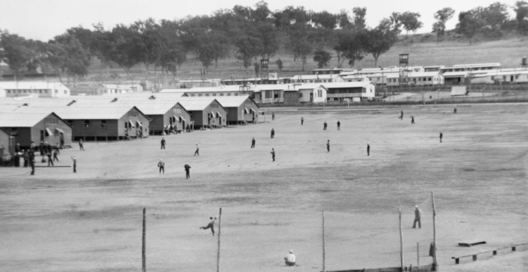Remembering the Cowra Breakout – 80 years on
Eighty years ago today, a lone bugle cut through the frosty morning air of No. 12 Prisoner of War Compound in Cowra, New South Wales. Sounded by fighter pilot Toyoshima Hajime – the first Japanese airman captured on Australian soil – it was a call to arms that would begin the only Second World War land battle fought on Australian soil.
With a loud cry of ‘Banzai’, 1,104 Japanese prisoners of war (POWs) rushed the barbed-wire fences and set fire to the camp buildings.
Privates Ben Hardy and Ralph Jones of the 22nd Garrison Battalion pushed through the prisoners and manned one of the camp’s Vickers machine guns. They fired it until they were overwhelmed, knifed and clubbed to death by prisoners. It is believed that Hardy managed to disable the gun in the final moments of his life so it couldn’t be turned on his mates. Hardy and Jones were posthumously awarded the George Cross.
Private Charles Shepherd, also of the 22nd Garrison Battalion, was killed during the breakout as he emerged from a guardroom. Lieutenant Harry Doncaster, of the 19th Australian Infantry Training Battalion, was killed while trying to catch some of the escaped prisoners in the days after the breakout.
During the breakout and in the 9 days that followed, 234 Japanese prisoners died, 108 were wounded, and more than 300 were recaptured.
Those who took part in the break-out had no expectation of getting back to Japan. Many were angered by the planned move to the internment and POW camp at Hay and the subsequent separation of NCOs and privates. Some were driven by the code of Bushidō, which demanded that they regain the honour they had lost by being captured. Many were willing to die rather than remain a prisoner. Toyoshima Hajime took his own life the moment he got over the fence.
In 1952, Cowra RSL Branch President and Second World War veteran Albert Oliver decided it was time to heal old wounds and began looking after the neglected Japanese war graves, which are still cared for in perpetuity by the Department of Veterans' Affairs through the Office of Australian War Graves on behalf of the Japanese Government.
Albert later travelled to Japan to raise funds for the Cowra Japanese Garden and Cultural Centre, an enduring sign of peace between Australia and Japan.
Eighty years on we come together to remember all who lost their lives during the Cowra Breakout.
Lest we forget.
To learn more about the Cowra Breakout, visit our Anzac Portal.

Image courtesy of the Australian War Memorial - Japanese prisoners of war playing baseball. This photograph was taken for the far eastern liaison office as a basis for propaganda leaflets to be dropped over Japanese held islands during the Second World War.
